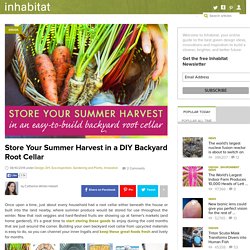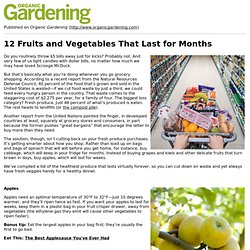

DIY: Learn How To Build a Root Cellar From Recycled Materials. Once upon a time, just about every household had a root cellar either beneath the house or built into the land nearby, where summer produce would be stored for use throughout the winter.

Now that root veggies and hard-fleshed fruits are showing up at farmer's markets (and home gardens!) , it's a great time to start storing these goods to enjoy during the cold months that are just around the corner. Building your own backyard root cellar from upcycled materials is easy to do, so you can channel your inner Ingalls and keep these great foods fresh and lively for months.
Creating a cellar for food storage is an ideal method for many reasons: an underground chamber doesn’t see much temperature fluctuation, and during the colder months the conditions within will be nice and cool. In the days before every home had a fridge (and in places where electricity is scarce), root cellaring has been a way of keeping food from spoiling by simple refrigeration and humidity control. Pails Fridge/Freezer.
12 Fruits and Vegetables That Last for Months. Do you routinely throw $5 bills away just for kicks?

Probably not. And very few of us light candles with dollar bills, no matter how much we may have loved Scrooge McDuck. But that’s basically what you’re doing whenever you go grocery shopping. According to a recent report from the Natural Resources Defense Council, 40 percent of the food that’s grown and sold in the United States is wasted—if we cut food waste by just a third, we could feed every hungry person in the country. That waste comes to the staggering cost of $2,275 per year, for a family of four. Another report from the United Nations pointed the finger, in developed countries at least, squarely at grocery stores and consumers, in part because the former pushes “great bargains” that encourage the latter to buy more than they need. The solution, though, isn’t cutting back on your fresh produce purchases. Apples Apples need an optimal temperature of 30°F to 32°F—just 10 degrees warmer, and they’ll ripen twice as fast. Beets Garlic. How Long Will it Store? - Longterm Storage.
Four Factors That Effect Food Storage Storage Life Notes About Specific Foods Introduction Determining the storage life of foods is at best an inexact science as there are so many variables.

These range from the condition your food was in when you first purchased it and includes many other factors. This information should be used as a general guide only, and should not be followed "as the gospel truth" because your results may be different. Four Factors that effect food storage: Factor #1: The Temperature Temperature has more to do with how long well dried foods store than anything else. Let's look at a couple of real life examples of good and poor food storage practices: Consider an unopened paper bag of white flour which had been stored at 70 degrees F, in a dry climate.
The experts give brown rice a 6 month storage life because of all the oils in it that go rancid. Factor #2: Product moisture content Factor #3: Atmosphere the product is stored in Seeds store better in nitrogen. Jihyun Ryou - a Korean artist about her storage solution for vegetables. How to Store Vegetables & Fruit Without Plastic. Oven Canning for Long Term Storage. Fill mason jars with dried goods for oven canning. Leave 1/2″ of head space. Dried goods make great emergency food if stored properly. But it’s no fun opening a box of pancake mix to find meal worms making a meal of your precious food (unless you like the extra protein).
You can stock up on survival foods specially prepared to last for years, but it can get pretty pricey. If you want to save some dough and do it yourself, oven canning is the way to go. Oven canning works great for prepping dried goods to stay fresh for years. You’ll need just a few things to get started: Canning jarsCanning lids and screw bandsWide mouth funnelDried goodsOvenPotholders and towels Half gallon and quart jars are a great size for most foods, but you can use pint jars if you’re preserving food for just one person. White rice, oats, and other grainsBeans and lentilsFlourBaking mixesSpices, salt, baking soda, etc. Oven canning kills insects and seals jars to keep out moisture. Instant Cinnamon and Sugar Oatmeal.